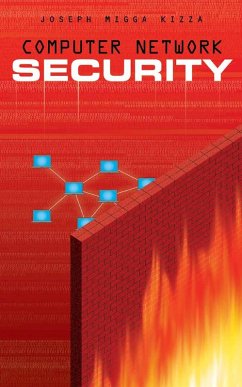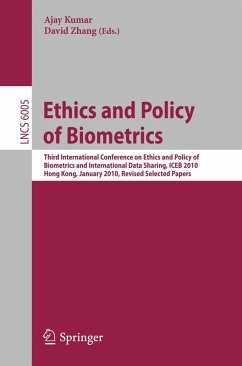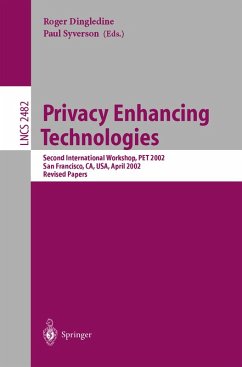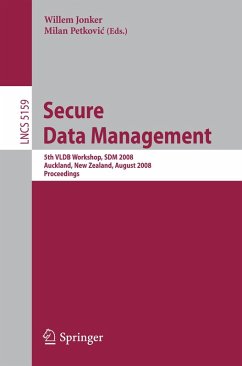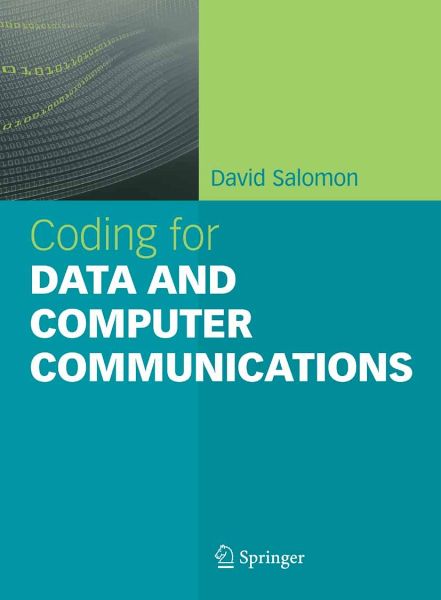
Coding for Data and Computer Communications (eBook, PDF)
Versandkostenfrei!
Sofort per Download lieferbar
73,95 €
inkl. MwSt.
Weitere Ausgaben:

PAYBACK Punkte
37 °P sammeln!
Digital data is heavily used when generating, storing, and transmitting information, and special codes are used to represent the data and to control its size, reliability, and security. Data coding is therefore a highly important, and indeed increasingly critical, discipline for data and computer communications.In a unique, single volume, this highly versatile text/reference introduces readers to the importance of channel coding (error-correcting codes), secure coding (cryptography), and source coding (data compression). It is organized in three main parts and uses clear, nonmathematical expla...
Digital data is heavily used when generating, storing, and transmitting information, and special codes are used to represent the data and to control its size, reliability, and security. Data coding is therefore a highly important, and indeed increasingly critical, discipline for data and computer communications.
In a unique, single volume, this highly versatile text/reference introduces readers to the importance of channel coding (error-correcting codes), secure coding (cryptography), and source coding (data compression). It is organized in three main parts and uses clear, nonmathematical explanations to develop the concepts, principles, and techniques in each area of coding. Requiring only a general familiarity with computer methods, the book deals with all aspects of coding and its relevance to fast, secure, and reliable data transmission and storage.
Features & Benefits:
*Presents comprehensive coverage of areas of coding often found in separate books, and stresses data coding's relevance in today's world
*Provides a wealth of examples and exercises (with solutions) to help readers easily grasp the material
*Incorporates an extensive chapter on data hiding, a sparsely documented topic of increasing importance in the community
*Includes an author-supplied website with supplementary material
*Possesses a detailed bibliography and helpful glossary, index, and appendixes (including projects for self-study).
Computer scientists, electrical engineers, and other professionals will find this up-to-date, accessible volume an essential resource about key areas, problems, and methods associated with data coding. Its straightforward approach also makes it very suitable for students taking courses on computer networks, coding and encryption, data communications, and information theory and coding.
David Salomon is a professoremeritus of computer science at California State University, Northridge. He has authored numerous articles and books, including Data Compression: The Complete Reference (Third Edition), Guide to Data Compression Methods, and Data Privacy and Security, and Computer Graphics and Geometric Modeling.
Key Topics:
>> Error-control codes
>> Image compression methods
>> Cipher types
>> Public-key cryptography
>> Check digits
>> Error detection
>> Statistical methods of source coding
>> Steganography (data hiding)
>> Encryption codes
>> Security / Cryptography
>> Beginning / Intermediate
In a unique, single volume, this highly versatile text/reference introduces readers to the importance of channel coding (error-correcting codes), secure coding (cryptography), and source coding (data compression). It is organized in three main parts and uses clear, nonmathematical explanations to develop the concepts, principles, and techniques in each area of coding. Requiring only a general familiarity with computer methods, the book deals with all aspects of coding and its relevance to fast, secure, and reliable data transmission and storage.
Features & Benefits:
*Presents comprehensive coverage of areas of coding often found in separate books, and stresses data coding's relevance in today's world
*Provides a wealth of examples and exercises (with solutions) to help readers easily grasp the material
*Incorporates an extensive chapter on data hiding, a sparsely documented topic of increasing importance in the community
*Includes an author-supplied website with supplementary material
*Possesses a detailed bibliography and helpful glossary, index, and appendixes (including projects for self-study).
Computer scientists, electrical engineers, and other professionals will find this up-to-date, accessible volume an essential resource about key areas, problems, and methods associated with data coding. Its straightforward approach also makes it very suitable for students taking courses on computer networks, coding and encryption, data communications, and information theory and coding.
David Salomon is a professoremeritus of computer science at California State University, Northridge. He has authored numerous articles and books, including Data Compression: The Complete Reference (Third Edition), Guide to Data Compression Methods, and Data Privacy and Security, and Computer Graphics and Geometric Modeling.
Key Topics:
>> Error-control codes
>> Image compression methods
>> Cipher types
>> Public-key cryptography
>> Check digits
>> Error detection
>> Statistical methods of source coding
>> Steganography (data hiding)
>> Encryption codes
>> Security / Cryptography
>> Beginning / Intermediate
Dieser Download kann aus rechtlichen Gründen nur mit Rechnungsadresse in A, B, BG, CY, CZ, D, DK, EW, E, FIN, F, GR, HR, H, IRL, I, LT, L, LR, M, NL, PL, P, R, S, SLO, SK ausgeliefert werden.




